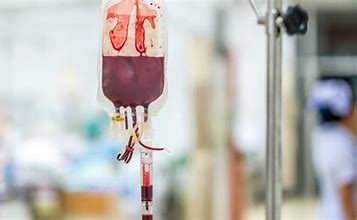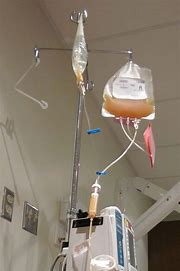What is a transfusion?
A transfusion is the process of transferring whole blood or blood components from one person (donor) to another (recipient).
Australia has one of the safest blood supplies in the world.
- The blood is tested before transfusion to make sure that your blood and the donated blood are compatible.
- Donor blood is tested for HIV/AIDS, Hepatitis B, Hepatitis C and human T-lymphotropic virus.
A donor’s blood is separated into:
- Red blood cells
- Platelets
- Plasma
Patients with lymphoma usually receive irradiated blood and platelets. Irradiated blood has been treated with x-rays to prevent any white blood cells that are remaining in the blood from dividing. The red blood cells and platelets still work after being irradiated.
On this page we will be covering red blood cell transfusions and platelet transfusions.
Red blood cell transfusions

What are red blood cells?
Red blood cells are doughnut shaped cells. They make up 40 percent of our total blood volume and are red because of a protein called haemoglobin. Red cells carry oxygen to all the cells in the body.
The average lifespan of a red blood cell is 120 days. Their function is to:
- Carry oxygen to all parts of the body
- Remove waste products from the body
When will I need a blood transfusion?
Red blood cell transfusions are sometimes needed if a patient becomes anaemic. Anaemia is a low red blood cell count.
To check whether for anaemia, your doctor will order a full blood examination to measure haemoglobin (Hb) count. Generally, patients are not transfused until their haemoglobin level is 70 g/L or below or if there are other symptoms.
- A normal Hb counts for a male (adult) = 130 – 180 g/L
- A normal Hb counts for a female (adult) = 120 – 160 g/L
What to expect during a blood transfusion?
Red blood cell transfusion is given through a drip (IV). The transfusion may feel cold but should not hurt. Patients are carefully monitored during the infusion.
One bag of blood usually takes about 2 hours to be transfused and should take no longer than 4 hours
Signs of transfusion reaction may include:
- Rash
- Hives
- Nausea
- vomiting
- Chest pain
- Fever
- Shaking
- Itching
- Fast or irregular heart rate
- Difficulty breathing
- Pain at needle site
Platelet transfusions

What are platelets?
Platelets are small, disc-shaped cell fragments. A bag of platelets is a cloudy yellow colour.
When is a platelet transfusion needed?
Platelet transfusion may be required for low platelet count (thrombocytopenia). Platelets assist with forming blood clots. Low platelets may cause increased bruising or bleeding that will not stop.
The doctor will order a regular full blood examination (FBE). Normal platelet count is 150-400.
The average lifespan of a platelet in the body is 8 to 12 days
Their function is to:
- Prevent or stop bleeding
- Platelets also contain growth factors that help to repair damaged body tissue.
What to expect during a platelet transfusion?
Platelet transfusion is given through a drip (IV). The transfusion may feel cold but should not hurt. Patients are carefully monitored during the infusion.
Platelets are usually given over 30 to 60 minutes.
Signs of transfusion reaction may include:
- Rash
- Hives
- Nausea
- vomiting
- Chest pain
- Fever
- Shaking
- Itching
- Fast or irregular heart rate
- Difficulty breathing
- Pain at needle site

